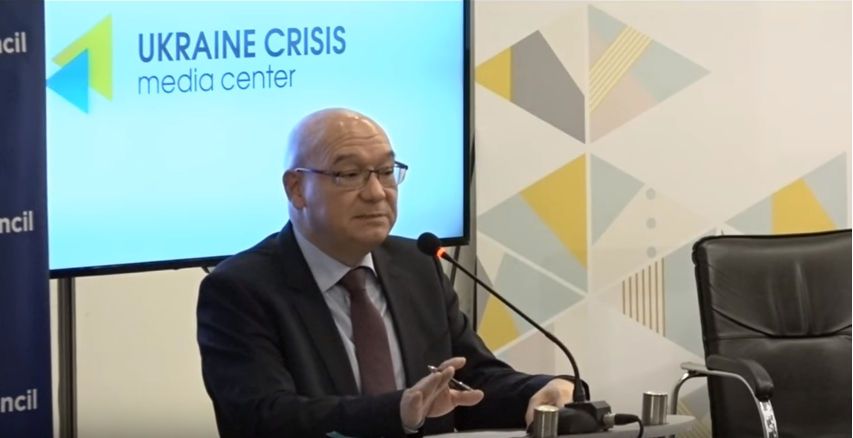International experts and Ukrainian civil society actors discuss the main challenges the IDPs are facing as well as the steps to be taken to help resolve them on the part of the state, international stakeholders, and civil society actors.
Main challenges internally displaced persons face in their new places of residence include access to pensions and social benefits, finding a permanent working and residence place, as well as integration in the new communities. These problems and the possible ways to resolve them were discussed by activists and international experts within the discussion “Ukraine’s Internally Displaced Persons Hold a Key to Peace Agenda” organized by the Atlantic Council at Ukraine Crisis Media Center.
According to the UN data, three years after the conflict in eastern Ukraine started, one in four internally displaced persons (IDPs) still lives in unsatisfactory conditions. In the government-controlled part of Luhansk region, 74 percent of the population lives beyond the poverty line. The respective number in the government-controlled part of Donetsk region amounts to 66 percent, said Jock Mendoza-Wilson, Director of International and Investor Relations at the System Capital Management. In Luhansk region, the number of industrial plants in operation decreased by 17 percent through 2013-2015, in Donetsk region – by 60 percent. The unemployment rate in Luhansk region constitutes 18,3 percent, in Donetsk region – 15,6 percent. “When you ask a question ‘What do IDPs need?’- and it’s pretty straightforward, every piece of research has made it very clear: IDPs want housing, and they want jobs. If they don’t have housing and they don’t have jobs, then they become isolated from the community and in some ways isolated from entire Ukraine and its movement forward. […] You need a plan to provide accommodation, you need to provide programs for early recovery and development for the citizens to develop income, having an income they will be able to afford housing,” Jock Mendoza-Wilson emphasized.
According to IDPs, another challenge for them is the access to social payments. They often have to turn to courts to demand them. “We believe that the government should streamline the pension process and immediately resume payments to all eligible Ukrainians. […] Second, the government should reduce the bureaucratic burdens on displaced people who are trying to access social payments so they don’t have to resort to the judiciary,” emphasized Marie Yovanovitch, the US Ambassador to Ukraine.
Comprehensive state program is key to resolving the problems of IDPs. “In four years the state has failed to develop a clear vision as to the occupied territories, internally displaced persons, and its attitude to them. I see absolutely discriminative provisions of some laws that are being adopted. Until we stop the discriminative attitude to people, they will be transmitting positive signals neither to Crimea nor to the occupied territories of Donetsk and Luhansk regions. The state has to demonstrate a crystal-clear vision what to do with these territories and with the people, so that the internally displaced become the new opinion leaders in the areas that are currently beyond the government control,” emphasized Tamila Tasheva, Crimea SOS founder.
However, if the strategy for integration of IDPs into the local communities is not well-thought enough, it may come in contradiction with the Donbas reintegration perspective. “Today 68 percent of IDPs think that they have completely integrated into the local communities, 25 percent have partly integrated. It is these people who may efficiently and creatively adapt in the new residency place – these are the people whom Donbas will be lacking when Ukrainian reintegration will become part of the agenda. If we look at the opinion poll, 30 to 40 percent of these people are not going to return back to where they resided before the conflict. Without them, successful reintegration will not be possible. The state, local self-governance, and non-governmental organizations have to undertake a clear, well-thought strategy,” noted Yurii Temirov, Dean of the History Department at the Donetsk National University.
The strategy for internally displaced persons has to foresee the information campaign – both targeting the international community, the IDPs themselves as well as other Ukraine citizens. “One of the key messages for Ukrainians internally is that IDPs are just people like them. This can happen to anybody. I think it’s important for those who may not come in contact with the IDPs […] these are all Ukrainian people, they are all part of the future,” Marie Yovanovitch emphasized.
“More success stories on how the internally displaced persons have been able to integrate into the new communities need to be told. However, I would like to encourage the IDPs themselves to contact the Western society and demonstrate to them that despite the fact that the problem with IDPs in Ukraine is not so acute as in Syria or other countries, it does not mean that the EU has to close the eyes and pretend that the problem does not exist,” added Kateryna Smahliy, Director of the Kennan Institute Kyiv Office.
“In Ukraine, the situation is quite complex and IDPs remain quite vulnerable. […] Non-discrimination must be a key principle for all issues related to IDPs. It is important that a comprehensive policy regarding the IDPs covers their current needs. It is important to provide enough resources to institutions in charge of IDPs, in particular to the Ministry on the Affairs of the Temporarily Occupied Territories and IDPs,” emphasized Alain Aeschlimann, Head of Delegation of the International Committee of the Red Cross in Ukraine.




